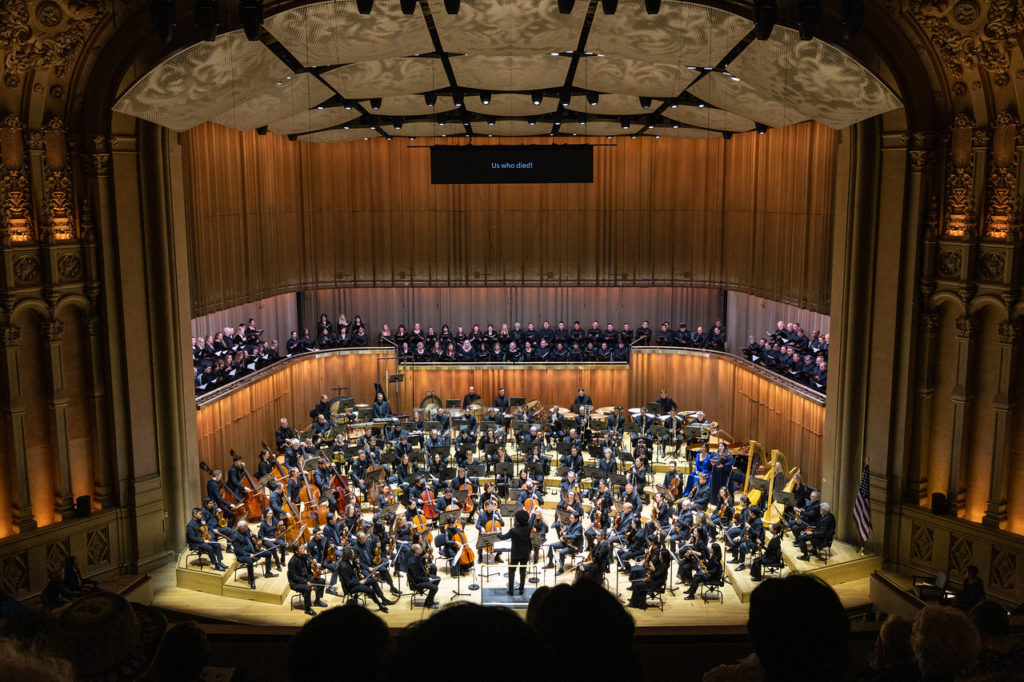San Diego Symphony’s Soaring, Inspiring Mahler Second Symphony: ‘Resurrection’
On Friday, for the San Diego Symphony’s second concert in the newly renovated Jacobs Music Center, Music Director Rafael Payare chose Gustav Mahler’s formidable Symphony No. 2 in C Minor. Known as the Resurrection Symphony, this 90-minute work calls for an unusually large orchestra, a massive chorus, two vocal soloists and a small cadre of off-stage instrumentalists.

San Diego Symphony Orchestra, Festival Chorus, and Vocal soloists in Mahler’s Second Symphony [photo (c.) Paul Cressey]
Resurrection proved a wise choice, filling the hall with surging crescendos and vibrant, sustained sonorities that frequently quickly disappeared into hushed pianissimos. The hall supported these widely contrasting sonic textures with amazing clarity and presence, giving the winds and percussion both greater definition and a more immediate character. I want to say the the hall integrated the strings and winds more effectively, but perhaps more varied concerts are needed to confirm this observation.
There is not the slightest doubt, however, that the orchestra under Payare’s inspired, astute direction gave a rich, scintillating account of this beloved Mahler Symphony, especially Payare’s masterfully shaped opening movement “Allegro maestoso.” The majestic outbursts of glorious brass fanfares and full orchestra climaxes that define this adventurous but structurally challenging 25-minute movement—the time span of most complete Haydn and Mozart symphonies—are separated by luminous transitions and an ominous march. Payare adroitly maintained the movement’s essential dramatic propulsion from start to finish, and the orchestra gave him unstinting radiant collaboration.
The dulcet string sections offered a most ingratiating second movement, “Andante moderato,” the composer’s gracious Ländler, the traditional Austrian dance in three-quarter time, graced by the first violins’ shimmering account of Mahler’s enchanting melody. HIs middle movement takes that benign triple meter into much darker territory, pumping up a sinister scherzo that Payare impelled with evident satisfaction.
Mezzo-soprano Anna Larsson’s serene yet radiant account of her “Urlicht” solo (usually translated as “Primal or Primeval Light”) in the fourth movement filled the hall with an astounding sense of wonder, ably complemented by lush oboe themes and a delicate descant from Concertmaster Jeff Thayer.
Following Beethoven’s example in his Ninth Symphony finale, in this symphony’s final movement Mahler summons the chorus to celebrate his theme of immortal life/resurrection. Orchestral variations on the foreboding “Dies Irae” theme set the stage for the muted choral affirmations that finally appear and commence their steady build to sublime affirmation. Aided by the fervor of mezzo-soprano Larsson and the clarion strength of soprano Angela Meade, the choir, trained by Chorus Master Andrew Megill, proved most impressive fortifying the the orchestra’s gleaming culmination with the declaration:
“You will rise again, my heart . . . What you have conquered will carry you to God!
At the Rady Shell in November of 2022, Payare and the orchestra gave the West Coast première of Thomas Larcher’s orchestral essay Time, Three Movements for Orchestra, a work co-commissioned by the San Diego Symphony. I was less than enthusiastic about this clangorous work bulging with loud, assertive overlapping themes, and hearing it a second time has not changed my mind. Although I did appreciate the subdued middle movement with its relaxed melodies tinged with nostalgia and crowned by a mellow chorale of winds and harp.
This concert was presented by the San Diego Symphony on October 4 & 5, 2024, in the Jacobs Music Center in downtown San Diego. It will be repeated in a Sunday matinee, October 6 in the same venue.

Ken Herman, a classically trained pianist and organist, has covered music for the San Diego Union, the Los Angeles Times’ San Diego Edition, and for sandiego.com. He has won numerous awards, including first place for Live Performance and Opera Reviews in the 2017, the 2018, and the 2019 Excellence in Journalism Awards competition held by the San Diego Press Club. A Chicago native, he came to San Diego to pursue a graduate degree and stayed.Read more…

Thank you for reviewing this concert. Always a pleasure hearing from you.